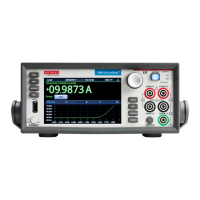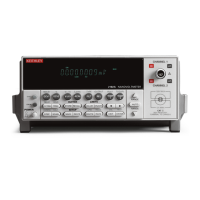7: Introduction to TSP operation Model 2461 Interactive SourceMeter® Instrument
7-2 2461-901-01 A/November 2015
Example 1
delay(0.250)
Emit a double-beep at 2400 Hz. The sequence is 0.5 s
on, 0.25 s off, 0.5 s on.
Example 2
You can use the results of a function-based command directly or assign variables to the results for
later access. The following code defines x and prints it.
x = math.abs(-100)
print(x)
Attributes
Attribute-based commands are commands that set the characteristics of an instrument feature or
operation. For example, some characteristics of TSP-enabled instruments are the model number
(localnode.model) and the brightness of the front-panel display (display.lightstate).
Attributes can be read-only, read-write, or write-only. They can be used as a parameter of a function
or assigned to another variable.
To set the characteristics, attribute-based commands define a value. For many attributes, the value is
in the form of a number, enumerated type, or a predefined constant.
Example 1: Set an attribute using a number
testData = buffer.make(500)
testData.capacity = 600
Use a function to create a buffer named
testData with a capacity of 500, then use the
bufferVar.capacity attribute to change the
Example 2: Set an attribute using an enumerated type
display.lightstate = display.STATE_LCD_75
This attribute controls the brightness of the
front-panel display and buttons. Setting this
attribute to display.STATE_LCD_75 sets the
brightness of the display and buttons to 75 % of
full brightness.
Example 3: Set an attribute using a constant
format.data = format.REAL64
Using the constant REAL64 sets the print format
to double precision floating point format.

